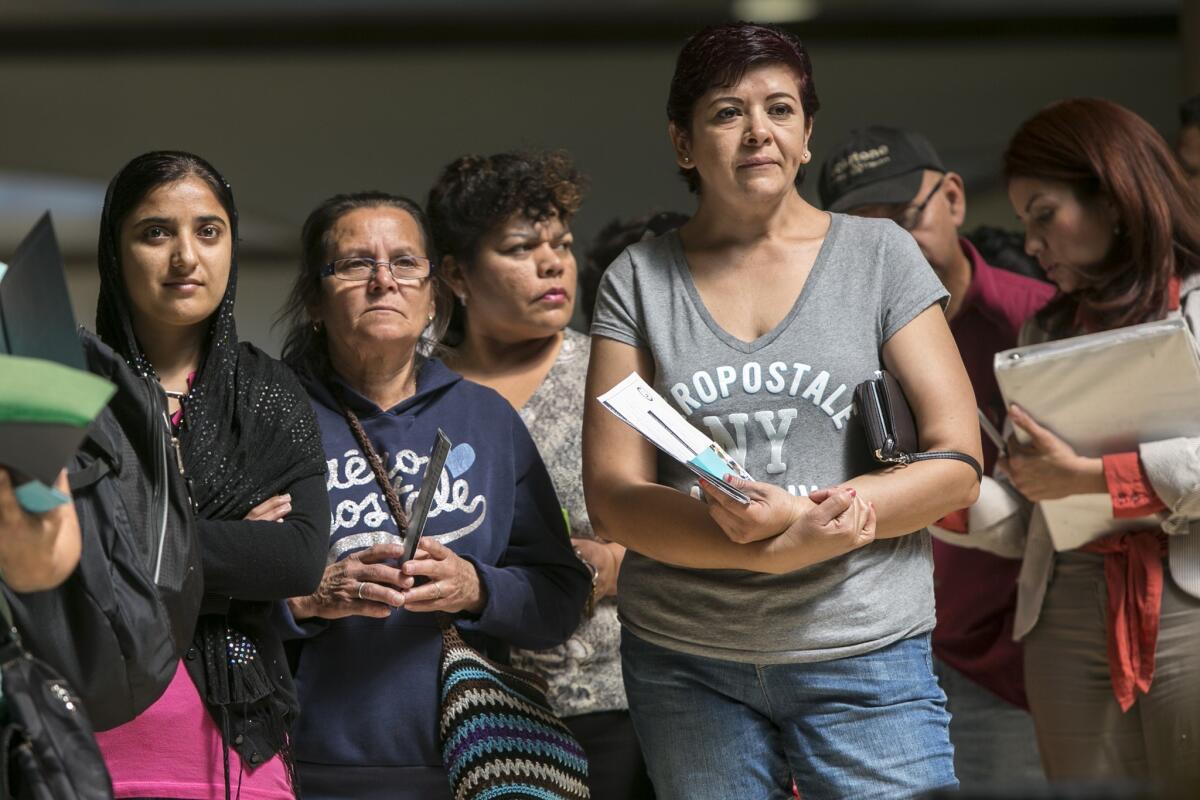L.A. County grapples with healthcare for remaining uninsured

One long period of Obamacare hand-wringing in Los Angeles County will end Monday, as the window for residents to enroll in mandatory healthcare coverage comes to a close.
But less than 24 hours later, county elected officials will be confronted with another politically sensitive facet of the nation’s healthcare overhaul: how to manage roughly a million people, many of them poor or undocumented, who will remain uninsured either because they aren’t eligible or failed to enroll.
Unlike some other counties in California, which are sidestepping the issue and leaving the problem largely to nonprofit free clinics, Los Angeles has committed to providing residents without coverage some system of government-supported medical care.
But the debate over what that care will look like — and how it will be funded — is only now getting started.
The county plans to set up a managed-care-like system for some uninsured residents, but advocates question whether the effort to get patients assigned to community clinics — and out of emergency rooms — will be enough. They plan to gather Tuesday before the county Board of Supervisors’ weekly meeting and push for additional funding to expand the program.
“People want to sign up,” said Tom Holler, co-executive director of One LA, a coalition of churches, synagogues and nonprofits that has been working to increase access to healthcare. “That’s why we have to ask the county for more money.”
Researchers at UCLA and UC Berkeley have estimated that 3 million to 4 million Californians will remain uninsured five years after the Affordable Care Act is implemented.
Anthony Wright, executive director of the advocacy group Health Access California, said that a third to one-half of L.A.’s million uninsured won’t have documentation of legal residency. That means they won’t be eligible for federally subsidized healthcare programs such as Medi-Cal and Covered California.
Counties take widely varying approaches to care for the uninsured. Some, like Fresno, contract with private hospitals, while others run public hospital systems. Some limit outlays to existing state and federal funding and required local matching contributions. Others, such as Los Angeles, devote additional money to the services.
Counties also have different income and legal residency eligibility requirements for patients to receive non-emergency healthcare.
In February, state Sen. Ricardo Lara (D-Bell Gardens) introduced a bill to make coverage available throughout the state to immigrants in the country illegally.
Critics argue that providing such services encourages immigrants to settle illegally in the state and county.
“These are self-inflicted wounds,” said Ira Mehlman, a spokesman for the Federation for American Immigration Reform, a Washington-based organization that seeks to stop illegal immigration. “County hospitals are overwhelmed with uninsured people, and they’ve been forced to come up with more money to accommodate these people — largely because they’ve encouraged them to come in.”
Wright said Los Angeles County’s size and its large numbers of immigrants in the country illegally make it an important laboratory for counties trying to figure out how to serve the uninsured.
Many patients without medical coverage show up at county clinics and emergency rooms needing to see a doctor, said Dr. Mitchell Katz, director of L.A. County’s Department of Health Services.
That relatively costly healthcare is paid for with a combination of federal, state and county funds, Katz said, making it difficult to determine local government costs.
In addition, the county pays $56 million a year from its local general government budget to run a program, known as Healthy Way L.A. Unmatched, that reimburses partner community clinics for caring for about 100,000 uninsured patients.
Katz’s department plans to relaunch that program this fall as a managed-care-type system that will be made available to those not covered by the Affordable Care Act or private insurance and whose income is less than 138% of the federal poverty level, or $15,856 for a household of one.
The new plan will issue membership cards to participants and assign them to a “medical home” — a nonprofit community clinic — that will coordinate their primary care. Clinics taking part will be paid a predetermined rate for each patient they take on, Katz said.
That should provide an incentive for them to treat patients more efficiently — keeping track of those who are chronically ill to keep them healthy and cutting out unnecessary and expensive visits to clinics and emergency rooms, he said.
“Primary care is one of the few interventions that has been shown to save money,” Katz said. “Doctors don’t order as many tests, or hospitalize patients as much when they know them.”
Katz is scheduled to update supervisors on the county’s implementation of healthcare reform and coverage of those who remain uninsured at Tuesday’s board meeting.
He said is not seeking funding increases for Healthy Way L.A. Unmatched.
“Our goal is to keep the pool of money about the same and the number of patients about the same,” Katz said. “I’m not saying, ‘Gee, I want you to give me a lot more money.’ I’m saying, ‘I’m going to do a better job with the amount of money and the number of people I have.’”
Advocates are lauding the county’s new managed-care-type program as a first step toward health coverage for all but are concerned that it won’t be enough to meet the need.
The Department of Health Services and the community clinics have not yet determined the flat rate that those providing medical services to the uninsured will receive. But “assuming a reasonable rate,” Holler said, “from our perspective the current funding won’t go far enough.”
Twitter: @LATerynbrown
More to Read
Sign up for Essential California
The most important California stories and recommendations in your inbox every morning.
You may occasionally receive promotional content from the Los Angeles Times.











